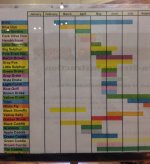Haha true. WAIT! Shouldn't MARCH browns hatch in march?!
No, uh, see, they are MAYflies.

When matching any bug, the main thing to think about is.
1. Size.
2. What life stage - i.e. are they taking surface nymphs just under the surface, emergers in the film, duns, spinners?
If it's one of those, pick a pattern which should put the fly where they're feeding it. Look at how the hackle is arranged on the fly and logic can tell you how it'll sit in the water.
If you don't see fish rising at all, throw on a nymph and dredge.
3. Color.
As a beginner you don't gotta worry about the difference between a pale evening dun and a sulpher, or a march brown vs. gray fox. Just observe trout. Feeding on top, or just underneath? Or taking nymphs on bottom?
Realistically, there's a reason generic flies, like an Adams, are so popular. Jack of all trades approach.
Give me a parachute sulpher and a parachute adams, both in sizes 12-18, and that'll approximate all life forms of 95% of the hatches PA has to offer. A parachute can be fished as an emerger, dun, or spinner by playing with floatant and presenting it the right way. Sulpher and Adams coloration covers light and dark colored bodies. And about the only 2 mayflies that fall outside of the 12-18 range are Green Drakes and tricos. Neither of which is "stumbled on" very often, they are hatches you specifically chase.
But if you do want to learn hatches, and I'm speaking to mayflies here (caddis is a different thing altogether), here's PA's mega hatches. There are, of course, other bugs PA has to offer. But if you are on a trout stream and there are large numbers of bugs and lots of fish rising to them all over, there's a 95% chance it's one of the below.
BWO - size 18ish. March-April. Light bodied.
Hendrickson - Size 12-14. April. Dark bodied.
March Brown - size 12ish. April-mid May. Dark bodied.
Sulpher - size 14-16. early May-early June. Light bodied.
Green Drake - Size 6-10. Late May-early June. Light bodied.
Cahills - Size 14-16. Late May-July. Light bodied.
BWO - size 14ish. June. Light bodied.
Trico - size 24-26. mid July-September. Dark bodied.
The main advantage to learning them has nothing to do with picking a more exact fly to match. It's more about knowing their timing and behavior, what streams they hatch on, whether they do so in riffles or slow water, etc. The benefit is that fish feed heavily during hatches, so if you can predict when and where that will happen, you can plan accordingly to put yourself in the right place at the right time. This is very achievable. People say that 95% of the time nothing is hatching and you should nymph. That's true, overall. But that other 5% is very predictable and many anglers will purposely choose to be on the water at those times. And that is often when the best fishing is to be had.
For instance, if you wanna fish sulphers, they're gonna hatch in the evening, and spinners just after dark. Don't even bother getting to the stream until dinnertime! On the other hand, if you wanna fish tricos, they hatch overnight, so that's out, but the spinner fall happens in the early morning, as soon as the sun burns through the fog. So get there at daylight and figure on being home by late morning.





